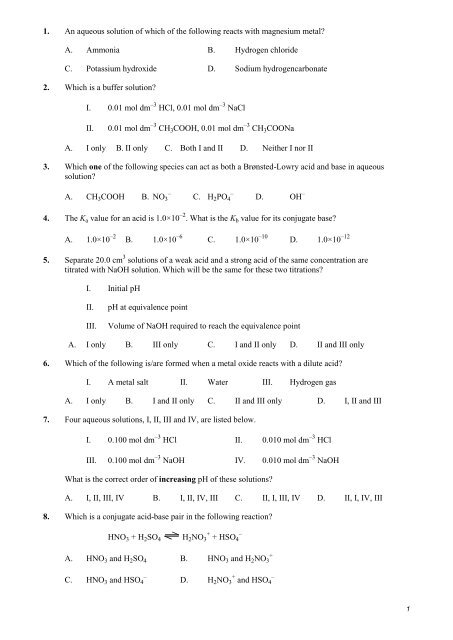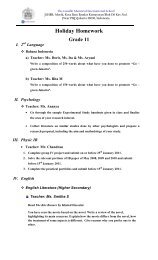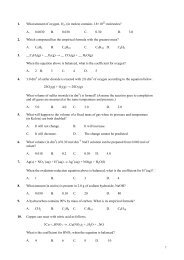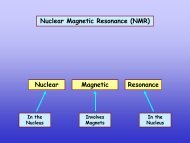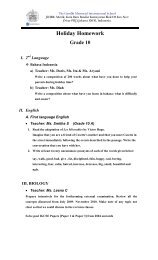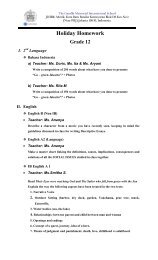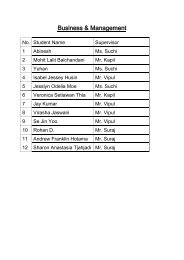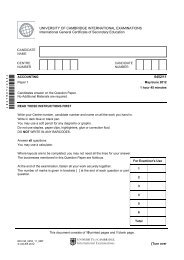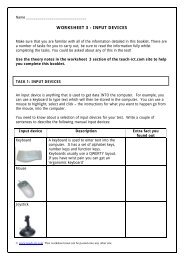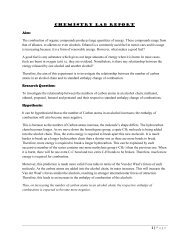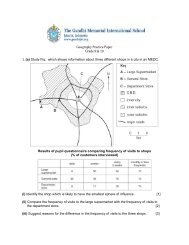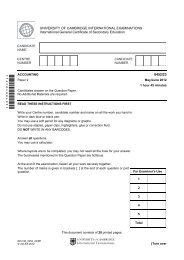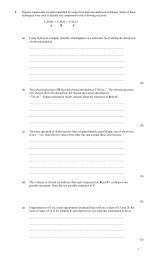Practise questions on acid bases
Practise questions on acid bases
Practise questions on acid bases
- No tags were found...
Create successful ePaper yourself
Turn your PDF publications into a flip-book with our unique Google optimized e-Paper software.
1. An aqueous soluti<strong>on</strong> of which of the following reacts with magnesium metal?A. Amm<strong>on</strong>ia B. Hydrogen chlorideC. Potassium hydroxide D. Sodium hydrogencarb<strong>on</strong>ate2. Which is a buffer soluti<strong>on</strong>?I. 0.01 mol dm –3 HCl, 0.01 mol dm –3 NaClII.0.01 mol dm –3 CH 3 COOH, 0.01 mol dm –3 CH 3 COONaA. I <strong>on</strong>ly B. II <strong>on</strong>ly C. Both I and II D. Neither I nor II3. Which <strong>on</strong>e of the following species can act as both a Brønsted-Lowry <strong>acid</strong> and base in aqueoussoluti<strong>on</strong>?A. CH 3 COOH B. NO 3–C. H 2 PO 4–D. OH –4. The K a value for an <strong>acid</strong> is 1.0×10 –2 . What is the K b value for its c<strong>on</strong>jugate base?A. 1.0×10 –2 B. 1.0×10 –6 C. 1.0×10 –10 D. 1.0×10 –125. Separate 20.0 cm 3 soluti<strong>on</strong>s of a weak <strong>acid</strong> and a str<strong>on</strong>g <strong>acid</strong> of the same c<strong>on</strong>centrati<strong>on</strong> aretitrated with NaOH soluti<strong>on</strong>. Which will be the same for these two titrati<strong>on</strong>s?I. Initial pHII.III.pH at equivalence pointVolume of NaOH required to reach the equivalence pointA. I <strong>on</strong>ly B. III <strong>on</strong>ly C. I and II <strong>on</strong>ly D. II and III <strong>on</strong>ly6. Which of the following is/are formed when a metal oxide reacts with a dilute <strong>acid</strong>?I. A metal salt II. Water III. Hydrogen gasA. I <strong>on</strong>ly B. I and II <strong>on</strong>ly C. II and III <strong>on</strong>ly D. I, II and III7. Four aqueous soluti<strong>on</strong>s, I, II, III and IV, are listed below.I. 0.100 mol dm –3 HCl II. 0.010 mol dm –3 HClIII. 0.100 mol dm –3 NaOH IV. 0.010 mol dm –3 NaOHWhat is the correct order of increasing pH of these soluti<strong>on</strong>s?A. I, II, III, IV B. I, II, IV, III C. II, I, III, IV D. II, I, IV, III8. Which is a c<strong>on</strong>jugate <strong>acid</strong>-base pair in the following reacti<strong>on</strong>?HNO 3 + H 2 SO 4 H 2 NO + –3 + HSO 4A. HNO 3 and H 2 SO 4 B.+HNO 3 and H 2 NO 3C. HNO 3 and HSO 4–D. H 2 NO 3 + and HSO 4–1
9. Which equati<strong>on</strong> represents an <strong>acid</strong>-base reacti<strong>on</strong> according to the Lewis theory but not theBrønsted-Lowry theory?A. NH 3 + HCl NH 4 Cl B. 2H 2 O H 3 O + + OH –C. NaOH + HCl NaCl + H 2 O D. CrCl 3 + 6NH 3 [Cr(NH 3 ) 6 ] 3+ + 3Cl –10. When the following 1.0 mol dm –3 aqueous soluti<strong>on</strong>s are arranged in order of increasing pH,which is the correct order?I. Amm<strong>on</strong>ium chloride II. Amm<strong>on</strong>ium ethanoate III. Sodium ethanoateA. I, II, III B. II, I, III C. III, I, II D. III, II, I11. An <strong>acid</strong>-base indicator, HIn, dissociates according to the following equati<strong>on</strong>.HIn(aq)colour AH + (aq) + In – (aq)colour BWhich statement about this indicator is correct?I. In a str<strong>on</strong>gly <strong>acid</strong>ic soluti<strong>on</strong> colour B would be seen.II.III.In a neutral soluti<strong>on</strong> the c<strong>on</strong>centrati<strong>on</strong>s of HIn(aq) and In – (aq) must be equal.It is suitable for use in titrati<strong>on</strong>s involving weak <strong>acid</strong>s and weak <strong>bases</strong>.A. I <strong>on</strong>ly B. II <strong>on</strong>ly C. III <strong>on</strong>ly D. N<strong>on</strong>e of the above12. Which substance can be dissolved in water to give a 0.1 mol dm –3 soluti<strong>on</strong> with a high pH and ahigh electrical c<strong>on</strong>ductivity?A. HCl B. NaCl C. NH 3 D. NaOH13. A buffer soluti<strong>on</strong> can be prepared by adding which of the following to 50 cm 3 of 0.10 mol dm –3CH 3 COOH(aq)?I. 50 cm 3 of 0.10 mol dm –3 CH 3 COONa(aq)II.III.25 cm 3 of 0.10 mol dm –3 NaOH(aq)50 cm 3 of 0.10 mol dm –3 NaOH(aq)A. I <strong>on</strong>ly B. I and II <strong>on</strong>ly C. II and III <strong>on</strong>ly D. I, II and III14. Which equati<strong>on</strong> represents an <strong>acid</strong>-base reacti<strong>on</strong> according to the Lewis theory but notaccording to the Brønsted-Lowry theory?A. CO 3 2– (aq) + 2H + (aq) → H 2 O(l) + CO 2 (g)B. Cu 2+ (aq) + 4NH 3 (aq) → Cu(NH 3 ) 4 2+ (aq)C. BaO(s) + H 2 O(l) → Ba 2+ (aq) + 2OH – (aq)D. NH 3 (g) + HCl(g) → NH 4 Cl(s)15. What is the c<strong>on</strong>centrati<strong>on</strong> of OH – i<strong>on</strong>s (in mol dm –3 ) in an aqueous soluti<strong>on</strong> in which2
[H + ] = 2.0×10 –3 mol dm –3 ? (K w = 1.0×10 –14 mol 2 dm –6 )A. 2.0×10 –3 B. 4.0×10 –6 C. 5.0×10 –12 D. 2.0×10 –1716. What is the relati<strong>on</strong>ship between K a and pK a ?A. pK a = –log K a B. pK a =C. pK a = log K a D. pK a =1.010K1.0Kaa1417. Which curve is produced by the titrati<strong>on</strong> of a 0.1 mol dm –3 weak base with 0.1 mol dm –3 str<strong>on</strong>g<strong>acid</strong>?A.12B.12pH84pH84Volume of titrantVolume of titrantC.12D.12pH84pH84Volume of titrantVolume of titrant18. The pH of a soluti<strong>on</strong> is 2. If its pH is increased to 6, how many times greater is the [H + ] of theoriginal soluti<strong>on</strong>?A. 3 B. 4 C. 1000 D. 10 00019. The <strong>acid</strong> dissociati<strong>on</strong> c<strong>on</strong>stant of a weak <strong>acid</strong> HA has a value of 1.0×10 –5 mol dm –3 .What is the pH of a 0.10 mol dm –3 aqueous soluti<strong>on</strong> of HA?A. 2 B. 3 C. 5 D. 620. Which mixture would produce a buffer soluti<strong>on</strong> when dissolved in 1.0 dm 3 of water?A. 0.50 mol of CH 3 COOH and 0.50 mol of NaOHB. 0.50 mol of CH 3 COOH and 0.25 mol of NaOHC. 0.50 mol of CH 3 COOH and 1.00 mol of NaOHD. 0.50 mol of CH 3 COOH and 0.25 mol of Ba(OH) 221. Which compound, when dissolved in aqueous soluti<strong>on</strong>, has the highest pH?A. NaCl B. Na 2 CO 3 C. NH 4 Cl D. NH 4 NO 33
22. In which reacti<strong>on</strong> is H 2 PO 4 – (aq) acting as a Brønsted-Lowry base?A. H 2 PO 4 – (aq) + NH 3 (aq) → HPO 4 2– (aq) + NH 4 + (aq)B. H 2 PO 4 – (aq) + OH – (aq) → HPO 4 2– (aq) + H 2 O(l)C. H 2 PO 4 – (aq) + C 2 H 5 NH 2 (aq) → HPO 4 2– (aq) + C 2 H 5 NH 3 + (aq)D. H 2 PO 4 – (aq) + CH 3 COOH(aq) → H 3 PO 4 (aq) + CH 3 COO – (aq)23. The pH of soluti<strong>on</strong> X is 1 and that of Y is 2. Which statement is correct about the hydrogen i<strong>on</strong>c<strong>on</strong>centrati<strong>on</strong>s in the two soluti<strong>on</strong>s?A. [H + ] in X is half that in Y. B. [H + ] in X is twice that in Y.C. [H + ] in X is <strong>on</strong>e tenth of that in Y. D. [H + ] in X is ten times that in Y.24. Which substances could be added to a soluti<strong>on</strong> of ethanoic <strong>acid</strong> to prepare an <strong>acid</strong>ic buffersoluti<strong>on</strong>?I. Hydrochloric <strong>acid</strong> II. Sodium ethanoate III. Sodium hydroxideA. I and II <strong>on</strong>ly B. I and III <strong>on</strong>ly C. II and III <strong>on</strong>ly D. I, II and III25. Which methods will distinguish between equimolar soluti<strong>on</strong>s of a str<strong>on</strong>g base and a str<strong>on</strong>g <strong>acid</strong>?I. Add magnesium to each soluti<strong>on</strong> and look for the formati<strong>on</strong> of gas bubbles.II.III.Add aqueous sodium hydroxide to each soluti<strong>on</strong> and measure the temperaturechange.Use each soluti<strong>on</strong> in a circuit with a battery and lamp and see how bright the lampglows.A. I and II <strong>on</strong>ly B. I and III <strong>on</strong>ly C. II and III <strong>on</strong>ly D. I, II and III26. The equati<strong>on</strong> for the reacti<strong>on</strong> between nitric <strong>acid</strong> and sulfuric <strong>acid</strong> is shown below.H 2 SO 4 + HNO 3 H 2 NO + –3 + HSO 4Which species are acting as <strong>acid</strong>s in this reacti<strong>on</strong> according to the Brønsted-Lowry theory?+A. H 2 SO 4 and HNO 3 B. H 2 SO 4 and H 2 NO 3C. HNO 3 and H 2 NO 3+D. H 2 NO 3 + and HSO 4–27. Which values are correct for a soluti<strong>on</strong> of NaOH of c<strong>on</strong>centrati<strong>on</strong> 0.010 mol dm –3 at 298 K?(K w = 1.0×10 –14 mol 2 dm –6 at 298 K)A. [H + ] = 1.0×10 –2 mol dm –3 and pH = 2.00B. [OH – ] = 1.0×10 –2 mol dm –3 and pH = 12.00C. [H + ] = 1.0×10 –12 mol dm –3 and pOH = 12.004
D. [OH – ] = 1.0×10 –12 mol dm –3 and pOH = 2.0028. Which soluti<strong>on</strong>, of c<strong>on</strong>centrati<strong>on</strong> 0.10 mol dm –3 , has the highest pH value?A. HCl(aq) B. MgCl 2 (aq) C. NaCl(aq) D. AlCl 3 (aq)29. Which statement about indicators is always correct?A. The mid-point of an indicator’s colour change is at pH = 7.B. The pH range is greater for indicators with higher pK a values.C. The colour red indicates an <strong>acid</strong>ic soluti<strong>on</strong>.D. The pK a value of the indicator is within its pH range.30. Lime was added to a sample of soil and the pH changed from 4 to 6. What was thecorresp<strong>on</strong>ding change in the hydrogen i<strong>on</strong> c<strong>on</strong>centrati<strong>on</strong>?A. increased by a factor of 2 B. increased by a factor of 100C. decreased by a factor of 2 D. decreased by a factor of 10031. When the following 1.0 mol dm –3 soluti<strong>on</strong>s are listed in increasing order of pH (lowest first),what is the correct order?A. HNO 3 H 2 CO 3 NH 3 Ba(OH) 2 B. NH 3 Ba (OH) 2 H 2 CO 3 HNO 3C. Ba (OH) 2 H 2 CO 3 NH 3 HNO 3 D. HNO 3 H 2 CO 3 Ba (OH) 2 NH 332. Which compound will dissolve in water to give a soluti<strong>on</strong> with a pH greater than 7?A. sodium chloride B. potassium carb<strong>on</strong>ateC. amm<strong>on</strong>ium nitrate D. lithium sulfate33. An aqueous soluti<strong>on</strong> has a pH of 10. Which c<strong>on</strong>centrati<strong>on</strong>s are correct for the i<strong>on</strong>s below?[H + (aq)] mol dm –3 [OH – (aq)] mol dm –3A. 10 4 10 –10B. 10 –4 10 –10C. 10 –10 10 –4D. 10 –10 10 –234. Which graph shows how the pH changes when a weak base is added to a str<strong>on</strong>g5
pHpH14 14AB7 70 0volume of basevolume of basepHpH14 14C7 7D<strong>acid</strong>?0 0volume of base volume of base35. When the following <strong>acid</strong>s are listed in decreasing order of <strong>acid</strong> strength (str<strong>on</strong>gest first), what isthe correct order?K abenzoic 6.31×10 –5chloroethanoic 1.38×10 –3ethanoic 1.74×10 –5A. chloroethanoic benzoic ethanoic B. benzoic ethanoic chloroethanoicC. chloroethanoic ethanoic benzoic D. ethanoic benzoic chloroethanoic36. Which change in [H + ] causes the biggest increase in pH?A. A change in [H + (aq)] from 1×10 –3 to 1×10 –2 mol dm –3B. A change in [H + (aq)] from 1×10 –3 to 1×10 –4 mol dm –3C. A change in [H + (aq)] from 1×10 –4 to 1×10 –2 mol dm –3D. A change in [H + (aq)] from 1×10 –4 to 1×10 –6 mol dm –337. The strengths of organic <strong>acid</strong>s can be compared using K a and pK a values. Which <strong>acid</strong> is thestr<strong>on</strong>gest?A. Acid A pK a = 6B. Acid B pK a = 3C. Acid C K a = 1×10 –5D. Acid D K a = 1×10 –438. Which methods can distinguish between soluti<strong>on</strong>s of a str<strong>on</strong>g m<strong>on</strong>oprotic <strong>acid</strong> and a weakm<strong>on</strong>oprotic <strong>acid</strong> of the same c<strong>on</strong>centrati<strong>on</strong>?6
I. Add magnesium to each soluti<strong>on</strong> and measure the rate of the formati<strong>on</strong> of gasbubbles.II. Add aqueous sodium hydroxide to each soluti<strong>on</strong> and measure the temperaturechange.III. Use each soluti<strong>on</strong> in a circuit with a battery and lamp and see how bright the lampglows.A. I and II <strong>on</strong>ly B. I and III <strong>on</strong>ly C. II and III <strong>on</strong>ly D. I, II and III39. Which species are a c<strong>on</strong>jugate pair according to the Brønsted-Lowry theory?A. CH 3 COOH and CH 3 CHO B. NH 3 and BF 3C. H 2 NO 3 + and NO 3–D. H 2 SO 4 and HSO 4–40. Which is the correct statement about the pH and pOH values of an aqueous soluti<strong>on</strong> at 25°C?A. pH + pOH =14.0 B. pH + pOH =1.0 ×10 –14C. pH × pOH =14.0 D. pH × pOH =1.0 ×10 –1441. Which salt, when dissolved in water to form a 1.0 mol dm –3 soluti<strong>on</strong>, produces the lowest pHvalue?A. Amm<strong>on</strong>ium chloride B. Amm<strong>on</strong>ium ethanoateC. Sodium ethanoate D. Sodium chloride42. Which is not a str<strong>on</strong>g <strong>acid</strong>?A. Nitric <strong>acid</strong> B. Sulfuric <strong>acid</strong> C. Carb<strong>on</strong>ic <strong>acid</strong> D. Hydrochloric <strong>acid</strong>43. Lime is added to a lake to neutralize the effects of <strong>acid</strong> rain. The pH value of the lake waterrises from 4 to 7. What is the change in c<strong>on</strong>centrati<strong>on</strong> of H + i<strong>on</strong>s in the lake water?A. An increase by a factor of 3 B. An increase by a factor of 1000C. A decrease by a factor of 3 D. A decrease by a factor of 100044. Which soluti<strong>on</strong> has the lowest pH value?A. Aluminium sulfate B. Sodium nitrate C. Potassium chloride D.Sodium ethanoate45. Which is a Brønsted-Lowry <strong>acid</strong>-base pair?A. H 2 O and O 2– B. CH 3 COOH and CH 3 COO –C. NH 4 + and NH 2–D. H 2 SO 4 and SO 42–46. Which neutralizati<strong>on</strong> reacti<strong>on</strong> could use phenolphthalein (pK a = 9.3) and not methyl orange (pK a= 3.7) as an indicator?A. NaOH(aq) and HNO 3 (aq) B. NH 3 (aq) and CH 3 COOH(aq)C. NaOH(aq) and CH 3 COOH(aq) D. NH 3 (aq) and HNO 3 (aq)47. Water dissociates according to the equati<strong>on</strong>H 2 O(l) H + (aq) + OH – (aq) H = +56 kJ7
At 25C water has a pH of 7. Which of the following occurs when water is heated to 30C?A. It remains neutral and its pH decreases. B. It becomes <strong>acid</strong>ic and its pH decreases.C. It remains neutral and its pH increases. D. It becomes <strong>acid</strong>ic and its pH increases.48. Which mixture would produce a buffer soluti<strong>on</strong> when dissolved in 1.0 dm 3 of water?A. 0.30 mol of NH 3 (aq) and 0.30 mol of HCl(aq)B. 0.30 mol of NH 3 (aq) and 0.15 mol of HCl(aq)C. 0.30 mol of NH 3 (aq) and 0.60 mol of HCl(aq)D. 0.30 mol of NH 3 (aq) and 0.15 mol of H 2 SO 4 (aq)49. Soluti<strong>on</strong>s of hydrochloric <strong>acid</strong> (HCl(aq)) and ethanoic <strong>acid</strong> (CH 3 COOH(aq)) of the samec<strong>on</strong>centrati<strong>on</strong> reacted completely with 5.0 g of calcium carb<strong>on</strong>ate in separate c<strong>on</strong>tainers. Whichstatement is correct?A. CH 3 COOH(aq) reacted slower because it has a lower pH than HCl(aq).B. A smaller volume of CO 2 (g) was produced with CH 3 COOH(aq) than with HCl(aq).C. A greater volume of CO 2 (g) was produced with CH 3 COOH(aq) than with HCl(aq).D. The same volume of CO 2 (g) was produced with both CH 3 COOH(aq) and HCl(aq).50. Soluti<strong>on</strong>s of hydrochloric <strong>acid</strong> (HCl(aq)) and ethanoic <strong>acid</strong> (CH 3 COOH(aq)) of the samec<strong>on</strong>centrati<strong>on</strong> reacted completely with 5.0 g of calcium carb<strong>on</strong>ate in separate c<strong>on</strong>tainers. Whichstatement is correct?A. CH 3 COOH(aq) reacted slower because it has a lower pH than HCl(aq).B. A smaller volume of CO 2 (g) was produced with CH 3 COOH(aq) than with HCl(aq).C. A greater volume of CO 2 (g) was produced with CH 3 COOH(aq) than with HCl(aq).D. The same volume of CO 2 (g) was produced with both CH 3 COOH(aq) and HCl(aq).51. Amm<strong>on</strong>ia (NH 3 ) is a weak base in aqueous soluti<strong>on</strong> with an i<strong>on</strong>izati<strong>on</strong> c<strong>on</strong>stant K b . Whatexpressi<strong>on</strong> is equal to the i<strong>on</strong>izati<strong>on</strong> c<strong>on</strong>stant for the following reacti<strong>on</strong>?NH 4 + (aq) + H 2 O(l)NH 3 (aq) + H 3 O + (aq)A.KKwaB.KKawC.KKwbD.KKbw52. The pK a values of four <strong>acid</strong>s are as follows.W 4.87 X 4.82 Y 4.86 Z 4.85What is the correct order when these <strong>acid</strong>s are arranged in order of increasing <strong>acid</strong> strength?A. X, Z, Y, W B. X, Y, Z, W C. W, Z, Y, X D. W, Y, Z, X53. 10 cm 3 of 0.01 mol dm –3 nitric <strong>acid</strong> (HNO 3 ) is diluted with 90 cm 3 of water. What is the pH ofthe resulting soluti<strong>on</strong>?8
A. 1 B. 2 C. 3 D. 454. A base of c<strong>on</strong>centrati<strong>on</strong> 0.10 mol dm –3 is titrated with 25 cm 3 of an <strong>acid</strong> of c<strong>on</strong>centrati<strong>on</strong> 0.10mol dm –3 . Which base-<strong>acid</strong> pair would have the highest pH at the equivalence point?A. NaOH(aq) and CH 3 COOH(aq) B. NaOH(aq) and HNO 3 (aq)C. NH 3 (aq) and HNO 3 (aq) D. NH 3 (aq) and CH 3 COOH(aq)55. Which <strong>acid</strong>s are str<strong>on</strong>g?I. HCl(aq) II. HNO 3 (aq) III. H 2 SO 4 (aq)A. I and II <strong>on</strong>ly B. I and III <strong>on</strong>ly C. II and III <strong>on</strong>ly D. I, II and III56. The pH of a soluti<strong>on</strong> changes from pH = 1 to pH = 3. What happens to the [H + ] during this pHchange?A. It increases by a factor of 100. B. It decreases by a factor of 100.C. It increases by a factor of 1000. D. It decreases by a factor of 1000.57. What is the c<strong>on</strong>jugate base of the HSO 4 – (aq) i<strong>on</strong>?A. H 2 SO 4 (aq) B. SO 4 2– (aq) C. H 2 O(l) D. H 3 O + (aq)58. What is the value of [H + ] in a buffer soluti<strong>on</strong> in which [CH 3 COOH] = 2.0 mol dm –3 and[CH 3 COO – ] 1.0 mol dm –3 ? For CH 3 COOH, K a = 1.8×10 –5 mol dm –3 .A. 6.0×10 –3 B. 3.6×10 –5 C. 1.8×10 –5 D. 9.1×10 –659. Which salt forms the most <strong>acid</strong>ic soluti<strong>on</strong> when added to water?A. NaCl B. MgSO 4 C. Al(NO 3 ) 3 D. KHCO 360. An <strong>acid</strong>-base indicator has a pK a value of 4.0. At what pH will this indicator change colour?A. 2.0 B. 4.0 C. 8.0 D. 12.061. Which species can act as a Lewis <strong>acid</strong>?A. BF 3 B. OH – C. H 2 O D. NH 362. Which substance, when dissolved in water, to give a 0.1 mol dm –3 soluti<strong>on</strong>, has the highest pH?A. HCl B. NaCl C. NH 3 D. NaOH63. Which methods will distinguish between equimolar soluti<strong>on</strong>s of a str<strong>on</strong>g base and a str<strong>on</strong>g <strong>acid</strong>?I. Add magnesium to each soluti<strong>on</strong> and look for the formati<strong>on</strong> of gas bubbles.II.III.Add aqueous sodium hydroxide to each soluti<strong>on</strong> and measure the temperaturechange.Use each soluti<strong>on</strong> in a circuit with a battery and lamp and see how bright the lampglows.A. I and II <strong>on</strong>ly B. I and III <strong>on</strong>ly C. II and III <strong>on</strong>ly D. I, II and III9
64. Which values are correct for a 0.010 mol dm –3 soluti<strong>on</strong> of NaOH(aq) at 298 K?(K w = 1.0×10 –14 mol 2 dm –6 at 298 K)A. [H + ] = 1.0×10 –12 mol dm –3 and pH = 12.00B. [OH – ] = 1.0×10 –12 mol dm –3 and pH = 12.00C. [H + ] = 1.0×10 –12 mol dm –3 and pOH = 12.00D. [OH – ] = 1.0×10 –12 mol dm –3 and pOH = 12.0065. At 25°C, K a for an <strong>acid</strong> is 1.0×10 –2 . What is the value of K b for its c<strong>on</strong>jugate base?A. 1.0×10 2 B. 1.0×10 –2 C. 1.0×10 12 D. 1.0×10 –1266. Which statement about indicators is always correct?A. The mid-point of the pH range of an indicator is 7.B. The pH range is greater for indicators with higher pK a values.C. The colour red indicates an <strong>acid</strong>ic soluti<strong>on</strong>.D. The pK a value of the indicator is within its pH range.67. Define the terms str<strong>on</strong>g <strong>acid</strong> and weak <strong>acid</strong>. Using hydrochloric and ethanoic <strong>acid</strong> as examples,write equati<strong>on</strong>s to show the dissociati<strong>on</strong> of each <strong>acid</strong> in aqueous soluti<strong>on</strong>.………………………………………………………………………………………………………………………………………………………………………………………………………………………………………………………………………………………68. (i) Calcium carb<strong>on</strong>ate is added to separate soluti<strong>on</strong>s of hydrochloric <strong>acid</strong> and ethanoic <strong>acid</strong>of the same c<strong>on</strong>centrati<strong>on</strong>. State <strong>on</strong>e similarity and <strong>on</strong>e difference in the observati<strong>on</strong>s youcould make.…………………………………………………………………………………………..…………………………………………………………………………………………..(2)(ii)Write an equati<strong>on</strong> for the reacti<strong>on</strong> between hydrochloric <strong>acid</strong> and calcium carb<strong>on</strong>ate.…………………………………………………………………………………………..…………………………………………………………………………………………..(2)(iii) Determine the volume of 1.50 mol dm –3 hydrochloric <strong>acid</strong> that would react with exactly1.25 g of calcium carb<strong>on</strong>ate.…………………………………………………………………………………………..…………………………………………………………………………………………..(3)10
(iv) Calculate the volume of carb<strong>on</strong> dioxide, measured at 273 K and1.01×10 5 Pa, which would be produced when 1.25 g of calcium carb<strong>on</strong>ate reactscompletely with the hydrochloric <strong>acid</strong>.…………………………………………………………………………………………..…………………………………………………………………………………………..…………………………………………………………………………………………..(2)69. The graph below shows the change in pH when aqueous sodium hydroxide is added to 20 cm 3of aqueous hydrochloric <strong>acid</strong>.121110987pH65432100 5 10 15 20 25 30Volume of NaOH / cm 3By reference to the graph(i)state the [H + ] before any alkali is added.…………………………………………………………………………………………..…………………………………………………………………………………………..(1)(ii) state by how much the [H + ] changes after the additi<strong>on</strong> of 20 cm 3 of aqueous sodiumhydroxide.…………………………………………………………………………………………..…………………………………………………………………………………………..(1)(iii) determine the volume of the same sodium hydroxide soluti<strong>on</strong> needed to neutralize 20 cm 3of aqueous ethanoic <strong>acid</strong> of the same c<strong>on</strong>centrati<strong>on</strong> as the hydrochloric <strong>acid</strong>.…………………………………………………………………………………………..…………………………………………………………………………………………..(1)70. Predict whether each of the following soluti<strong>on</strong>s would be <strong>acid</strong>ic, alkaline or neutral. In each11
case explain your reas<strong>on</strong>ing.(i)0.1 mol dm –3 FeCl 3 (aq)…………………………………………………………………………………………..…………………………………………………………………………………………..(ii)0.1 mol dm –3 NaNO 3 (aq)…………………………………………………………………………………………..…………………………………………………………………………………………..(iii) 0.1 mol dm –3 Na 2 CO 3 (aq)…………………………………………………………………………………………..…………………………………………………………………………………………..71. The following graph shows how the pH changes during the titrati<strong>on</strong> of 10 cm 3 of asoluti<strong>on</strong> of a weak <strong>acid</strong> (HA) with 0.10 mol dm –3 NaOH.pH14131211109876543210 0 1 2 3 4 5 6 7 8 9 10 11 12 13 14Volume of 0.10 mol dmNaOH / cm–3 3(i)State the pH at the equivalence point and explain why the pH changes rapidly in thisregi<strong>on</strong>.…………………………………………………………………………………………..…………………………………………………………………………………………..(ii)Calculate the initial c<strong>on</strong>centrati<strong>on</strong> of the <strong>acid</strong> (HA).…………………………………………………………………………………………..…………………………………………………………………………………………..12
…………………………………………………………………………………………..…………………………………………………………………………………………..(iii)Calculate the [H + ] of the <strong>acid</strong> before any sodium hydroxide is added. Use this value todetermine the K a value and the pK a value of the <strong>acid</strong>.…………………………………………………………………………………………..…………………………………………………………………………………………..…………………………………………………………………………………………..…………………………………………………………………………………………..(5)72. A buffer soluti<strong>on</strong> can be made by dissolving 0.25 g of sodium ethanoate in 200 cm 3 of 0.10 moldm –3 ethanoic <strong>acid</strong>. Assume that the change in volume is negligible.(i)Define the term buffer soluti<strong>on</strong>.…………………………………………………………………………………………..…………………………………………………………………………………………..(ii) Calculate the c<strong>on</strong>centrati<strong>on</strong> of the sodium ethanoate in mol dm –3 .…………………………………………………………………………………………..…………………………………………………………………………………………..(iii) Calculate the pH of the resulting buffer soluti<strong>on</strong> by using informati<strong>on</strong> from Table 16 ofthe Data Booklet.…………………………………………………………………………………………..…………………………………………………………………………………………..73. The strength of an organic <strong>acid</strong> can be c<strong>on</strong>sidered in terms of the breaking of the O–H b<strong>on</strong>d inthe molecule.(a)State how the strength of an <strong>acid</strong> is related to the dissociati<strong>on</strong> c<strong>on</strong>stant, K a , of the <strong>acid</strong>,and to its pK a value.............................................................................................................................................................................................................................................................................(b)By referring to their structures, explain the difference in the <strong>acid</strong> strengths of ethanol andphenol...................................................................................................................................................................................................................................................................................................................................................................................................................74. Use the Data Booklet to find the pK a values of the following <strong>acid</strong>s. State how the presence ofsubstituent’s in carboxylic <strong>acid</strong>s affects their <strong>acid</strong> strengths. For each pair, explain the differencein <strong>acid</strong> strength by referring to the substituent.13
Ethanoic <strong>acid</strong> and propanoic <strong>acid</strong>Chloroethanoic <strong>acid</strong> and dichloroethanoic <strong>acid</strong>Chloroethanoic <strong>acid</strong> and fluoroethanoic <strong>acid</strong>..............................................................................................................................................................................................................................................................................................................................................................................................................................................................................................................................................................................................................................................................................................76. State and explain whether each of the following soluti<strong>on</strong>s will form a buffer soluti<strong>on</strong>.(i)A 1.0 dm 3 soluti<strong>on</strong> c<strong>on</strong>taining 0.10 mol NH 3 and 0.20 mol HCl.................................................................................................................................................................................................................................................................................................................................................................................(ii)A 1.0 dm 3 soluti<strong>on</strong> c<strong>on</strong>taining 0.20 mol NH 3 and 0.10 mol HCl......................................................................................................................................................................................................................................................77. An experiment was carried out to determine the c<strong>on</strong>centrati<strong>on</strong> of an aqueous soluti<strong>on</strong> ofamm<strong>on</strong>ia by titrating it with a soluti<strong>on</strong> of sulfuric <strong>acid</strong> of c<strong>on</strong>centrati<strong>on</strong> 0.150 mol dm –3 . It wasfound that 25.0 cm 3 of the amm<strong>on</strong>ia soluti<strong>on</strong> required 20.1 cm 3 of the sulfuric <strong>acid</strong> soluti<strong>on</strong> forneutralizati<strong>on</strong>.(a)Write the equati<strong>on</strong> for the reacti<strong>on</strong> and calculate the c<strong>on</strong>centrati<strong>on</strong>, in mol dm –3 , of theamm<strong>on</strong>ia soluti<strong>on</strong>...........................................................................................................................................................................................................................................................................(b)Several <strong>acid</strong>-base indicators are listed in Table 17 of the Data Booklet. State and explainwhich <strong>on</strong>e of the following indicators should be used for this experiment:bromocresol green, phenol red or phenolphthalein...........................................................................................................................................................................................................................................................................(c) Determine the pOH of a soluti<strong>on</strong> with an amm<strong>on</strong>ia c<strong>on</strong>centrati<strong>on</strong> of 0.121 mol dm –3 .(pK b of amm<strong>on</strong>ia is 4.75.)..........................................................................................................................................................................................................................................................................14
.....................................................................................................................................78. (i) Calculate the pH of a mixture of 50 cm 3 of amm<strong>on</strong>ia soluti<strong>on</strong> of c<strong>on</strong>centrati<strong>on</strong> 0.10 moldm –3 and 50 cm 3 of hydrochloric <strong>acid</strong> soluti<strong>on</strong> of c<strong>on</strong>centrati<strong>on</strong> 0.050 mol dm –3 ................................................................................................................................................................................................................................................................................................................................................................................................................79. The pH values of soluti<strong>on</strong>s of three organic <strong>acid</strong>s of the same c<strong>on</strong>centrati<strong>on</strong> were measured.<strong>acid</strong> X pH = 5<strong>acid</strong> Y pH = 2<strong>acid</strong> Z pH = 3(i)Identify which soluti<strong>on</strong> is the least <strong>acid</strong>ic.(1)(ii) Deduce how the [H + ] values compare in soluti<strong>on</strong>s of <strong>acid</strong>s Y and Z.(2)(iii)Arrange the soluti<strong>on</strong>s of the three <strong>acid</strong>s in decreasing order of electrical c<strong>on</strong>ductivity,starting with the greatest c<strong>on</strong>ductivity, giving a reas<strong>on</strong> for your choice.(2)(Total 5 marks)80. The equilibrium reached when ethanoic <strong>acid</strong> is added to water can be represented by thefollowing equati<strong>on</strong>:CH 3 COOH(l) + H 2 O(l)CH 3 COO – (aq)+H 3 O + (aq)Define the terms Brønsted-Lowry <strong>acid</strong> and Lewis base, and identify two examples of each ofthese species in the equati<strong>on</strong>.(Total 4 marks)81. The pH of a soluti<strong>on</strong> is 4.8. Using informati<strong>on</strong> from Table 17 of the Data Booklet, deduce andexplain the colours of the indicators bromophenol blue and phenol red in this soluti<strong>on</strong>.(Total 3 marks)82. Calculate the pH of a buffer soluti<strong>on</strong> c<strong>on</strong>taining 0.0500 mol dm –3 of ethanoic <strong>acid</strong>(K a = 1.7410 –5 ) and 0.100 mol –3 of sodium ethanoate.(Total 3 marks)83. Identify <strong>on</strong>e example of a str<strong>on</strong>g <strong>acid</strong> and <strong>on</strong>e example of a weak <strong>acid</strong>. Outline three differentmethods to distinguish between equimolar soluti<strong>on</strong>s of these <strong>acid</strong>s in the laboratory. State howthe results would differ for each <strong>acid</strong>.(Total 5 marks)84. Vinegar has a pH of approximately 3 and some detergents have a pH of approximately 8. Stateand explain which of these has the higher c<strong>on</strong>centrati<strong>on</strong> of H + and by what factor.(Total 1 mark)85. Describe the compositi<strong>on</strong> and behaviour of a buffer soluti<strong>on</strong>.86. (i) Define the term pH.(Total 3 marks)(1)15
(ii)A 25.0 cm 3 sample of 0.100 mol dm –3 hydrochloric <strong>acid</strong> was placed in a c<strong>on</strong>ical flask,and 0.100 mol dm –3 sodium hydroxide is added until a total of 50.0 cm 3 had been added.Sketch a graph of pH against volume of NaOH(aq) added, clearly showing the volume ofNaOH(aq) needed for complete reacti<strong>on</strong> and the pH values at the start, the equivalencepoint and finish.(4)(iii) The experiment in (ii) was repeated, but with a 25.0 cm 3 sample of 0.100 mol dm –3ethanoic <strong>acid</strong> in the c<strong>on</strong>ical flask instead of the hydrochloric <strong>acid</strong>. Use informati<strong>on</strong> fromTable 16 of the Data Booklet to calculate the pH at the start of the experiment. State theapproximate pH value at the equivalence point.(5)(Total 10 marks)87. (i) Describe how an indicator, HIn, works.(3)(ii)Name a suitable indicator for the reacti<strong>on</strong> between ethanoic <strong>acid</strong> and sodium hydroxide.Use informati<strong>on</strong> from Table 17 in the Data Booklet to explain your choice.(2)(Total 5 marks)88. (i) Identify two substances that can be added to water to form a basic buffer soluti<strong>on</strong>.(1)(ii)Describe what happens when a small amount of <strong>acid</strong> soluti<strong>on</strong> is added to the buffersoluti<strong>on</strong> prepared in (i). Use an equati<strong>on</strong> to support your explanati<strong>on</strong>.(2)(Total 3 marks)89. Define the terms Brønsted-Lowry <strong>acid</strong> and Lewis <strong>acid</strong>. For each type of <strong>acid</strong>, identify <strong>on</strong>eexample other than water and write an equati<strong>on</strong> to illustrate the definiti<strong>on</strong>.(Total 5 marks)90. Predict and explain whether an aqueous soluti<strong>on</strong> of 0.10 mol dm –3 AlCl 3 will be <strong>acid</strong>ic, alkalineor neutral.(Total 2 marks)91. A titrati<strong>on</strong> was carried out to determine the c<strong>on</strong>centrati<strong>on</strong> of 25.0 cm 3 of an aqueous soluti<strong>on</strong> ofnitric <strong>acid</strong>. The pH value of the liquid in the flask was measured as 0.100 mol dm –3 , aqueoussodium hydroxide was added. The results are shown <strong>on</strong> the graph below.141210pH8642010 20 30 40Volume of NaOH(aq) / cm 316
(i)Use the graph to determine the value of [H + ] of the nitric <strong>acid</strong> soluti<strong>on</strong>.(1)(ii) Determine the pH value when the value of [H + ] has decreased to 1×10 –3 mol dm –3 .(1)(iii)Use the graph to determine the volume of 0.100 mol dm –3 aqueous sodium hydroxidesoluti<strong>on</strong> needed to exactly neutralize the nitric <strong>acid</strong>.(1)(iv)Calculate the c<strong>on</strong>centrati<strong>on</strong>, in mol dm –3 , of the nitric <strong>acid</strong>.(2)(Total 5 marks)92. The pH values of three <strong>acid</strong>ic soluti<strong>on</strong>s, X, Y and Z, are shown in the following table:Soluti<strong>on</strong> Acid pHX HCl(aq) 2Y HCl(aq) 4Z CH 3 COOH(aq) 4(i)Soluti<strong>on</strong>s X and Z have the same <strong>acid</strong> c<strong>on</strong>centrati<strong>on</strong>. Explain, by reference to both <strong>acid</strong>s,why they have different pH values.(2)(ii)Deduce by what factor the values of [H + ] in soluti<strong>on</strong>s X and Y differ.(1)(Total 3 marks)93. In aqueous soluti<strong>on</strong> at 298 K, amm<strong>on</strong>ia is a weak base with a pK b value of 4.75 and a K b valueof 1.7×10 –5 mol dm –3 .(a)Write an equati<strong>on</strong> for the reacti<strong>on</strong> of amm<strong>on</strong>ia with water.........................................................................................................................................................................................................................................................................(1)(b) State the i<strong>on</strong>izati<strong>on</strong> c<strong>on</strong>stant expressi<strong>on</strong>, K b , for amm<strong>on</strong>ia.............................................................................................................................................................................................................................................................................................................................................................................................................(1)(c)Calculate the pH of a 0.25 mol dm –3 soluti<strong>on</strong> of amm<strong>on</strong>ia.................................................................................................................................................................................................................................................................................................................................................................................................................................................................................................................................................17
........................................................................................................................................................................................................................................................................(3)(Total 5 marks)94. (a) Explain why a 1.0 mol dm –3 soluti<strong>on</strong> of sodium hydroxide has a pH of 14 whereas1.0 mol dm –3 amm<strong>on</strong>ia soluti<strong>on</strong> has a pH of about 12. Use equati<strong>on</strong>s in your answer.(5)(b)20.0 cm 3 of a known c<strong>on</strong>centrati<strong>on</strong> of sodium hydroxide is titrated with a soluti<strong>on</strong> ofnitric <strong>acid</strong>. The graph for this titrati<strong>on</strong> is given13pH70 10 20below. Volume of nitric <strong>acid</strong> / cm 330(i)(ii)(iii)State an equati<strong>on</strong> for the reacti<strong>on</strong> between sodium hydroxide and nitric <strong>acid</strong>.Calculate the c<strong>on</strong>centrati<strong>on</strong> of the sodium hydroxide soluti<strong>on</strong> before the titrati<strong>on</strong>.From the graph determine the volume of nitric <strong>acid</strong> required to neutralize thesodium hydroxide and calculate the c<strong>on</strong>centrati<strong>on</strong> of the nitric <strong>acid</strong>.(1)(2)(2)(iv)Predict the volume of ethanoic <strong>acid</strong> of the same c<strong>on</strong>centrati<strong>on</strong> as the nitric <strong>acid</strong> in(b) (iii), required to neutralize 20.0 cm 3 of this sodium hydroxide soluti<strong>on</strong>.(1)(Total 11 marks)95. State and explain two methods, other than measuring pH, which could be used to distinguishbetween 1.0 mol dm –3 soluti<strong>on</strong>s of nitric <strong>acid</strong> and ethanoic <strong>acid</strong>.(Total 4 marks)96. Nitric <strong>acid</strong> and amm<strong>on</strong>ia may be used to make a buffer soluti<strong>on</strong>.(i)Describe the behaviour of a buffer soluti<strong>on</strong>.(2)(ii)Describe how you could prepare a buffer soluti<strong>on</strong> using 0.100 mol dm –3 soluti<strong>on</strong>s ofnitric <strong>acid</strong> and amm<strong>on</strong>ia.(3)(Total 5 marks)97. Propanoic <strong>acid</strong> is classified as a weak <strong>acid</strong>.18
(a)State the meaning of the term weak <strong>acid</strong>.........................................................................................................................................................................................................................................................................(1)(b)State, giving a reas<strong>on</strong> in each case, two methods other than measuring pH, that could beused to distinguish between 0.100 mol dm –3 propanoic <strong>acid</strong> and 0.100 mol dm –3 nitric<strong>acid</strong>.................................................................................................................................................................................................................................................................................................................................................................................................................................................................................................................................................(2)(Total 3 marks)98. State an equati<strong>on</strong> for the reacti<strong>on</strong> of propanoic <strong>acid</strong> with water. Identify <strong>on</strong>e c<strong>on</strong>jugateBrønsted-Lowry pair.........................................................................................................................................................................................................................................................................................................................................................................................................................................................................................................................................................................................(Total 2 marks)99. With reference to Table 16 in the Data Booklet, determine the pH of a 0.100 mol dm –3 soluti<strong>on</strong>of propanoic <strong>acid</strong>...........................................................................................................................................................................................................................................................................................................................................................................................................................................(Total 3 marks)100. 0.100 mol dm –3 hydrochloric <strong>acid</strong> soluti<strong>on</strong> is added to 25.0 cm 3 0.100 mol dm –3 amm<strong>on</strong>iasoluti<strong>on</strong> and the pH is recorded until a total of 35.0 cm 3 hydrochloric <strong>acid</strong> has been added.(i)Sketch a graph to show how the pH changes as hydrochloric <strong>acid</strong> is added to theamm<strong>on</strong>ia soluti<strong>on</strong>. Use a pH scale of 0–14, and an <strong>acid</strong> volume scale of 0–35 cm 3 .Explain the shape of the curve.(6)(ii)Use table 17 of the Data Booklet to suggest an indicator that could be used in the titrati<strong>on</strong>,explaining your choice.(2)(Total 8 marks)101. (i) State the compositi<strong>on</strong> of an <strong>acid</strong>ic buffer soluti<strong>on</strong>.(1)19
(ii)(iii)Suggest the identity of an <strong>acid</strong> and its amount that could be added to a soluti<strong>on</strong> c<strong>on</strong>taining0.10 mol amm<strong>on</strong>ia in order to prepare a buffer.Explain how the soluti<strong>on</strong> you prepare in (ii) can act as a buffer soluti<strong>on</strong> when a str<strong>on</strong>g<strong>acid</strong> and a str<strong>on</strong>g base are added to separate porti<strong>on</strong>s of it. Write an equati<strong>on</strong> to illustratethe buffer acti<strong>on</strong> in each case.(2)(4)(iv)Write an equati<strong>on</strong> for the reacti<strong>on</strong> of amm<strong>on</strong>ia with water, and write its K b expressi<strong>on</strong>.(2)(Total 9 marks)102. (a) Predict and explain, using equati<strong>on</strong>s where appropriate, whether the following soluti<strong>on</strong>sare <strong>acid</strong>ic, alkaline or neutral.(i)0.1 mol dm –3 FeCl 3 (aq)......................................................................................................................................................................................................................................................(1)(ii)0.1 mol dm –3 NaNO 3 (aq)......................................................................................................................................................................................................................................................(1)(iii) 0.1 mol dm –3 Na 2 CO 3 (aq)......................................................................................................................................................................................................................................................(1)(b) Acidic gases can be released into the atmosphere that have an envir<strong>on</strong>mental impact whenthey are deposited as <strong>acid</strong> rain. State two elements that form the <strong>acid</strong>ic gases and describetwo impacts they have <strong>on</strong> the natural envir<strong>on</strong>ment...........................................................................................................................................................................................................................................................................(3)(Total 6 marks)103. An experiment was carried out to determine the c<strong>on</strong>centrati<strong>on</strong> of aqueous amm<strong>on</strong>ia by titratingit with a 0.150 mol dm –3 sulfuric <strong>acid</strong> soluti<strong>on</strong>. It was found that 25.0 cm 3 of the aqueousamm<strong>on</strong>ia required 20.1 cm 3 of the sulfuric <strong>acid</strong> soluti<strong>on</strong> for neutralizati<strong>on</strong>.(a)(b)Write the equati<strong>on</strong> for the reacti<strong>on</strong> and calculate the c<strong>on</strong>centrati<strong>on</strong>, in mol dm –3 , of theaqueous amm<strong>on</strong>ia.Several <strong>acid</strong>-base indicators are listed in Table 16 of the Data Booklet. Identify <strong>on</strong>eindicator that could be used for this experiment. Explain your answer.(4)(3)(c) (i) Determine the pOH of 0.121 mol dm –3 aqueous amm<strong>on</strong>ia (pK b = 4.75).20
(ii)State what is meant by the term buffer soluti<strong>on</strong>, and describe the compositi<strong>on</strong> of an<strong>acid</strong> buffer soluti<strong>on</strong> in general terms.(4)(3)(iii)Calculate the pH of a mixture of 50.0 cm 3 of 0.100 mol dm –3 aqueous amm<strong>on</strong>iaand 50.0 cm 3 of 0.0500 mol dm –3 hydrochloric <strong>acid</strong> soluti<strong>on</strong>.(4)(Total 18 marks)104. Propanoic <strong>acid</strong>, CH 3 CH 2 COOH is a weak <strong>acid</strong>.(a)Give the equati<strong>on</strong> for the i<strong>on</strong>izati<strong>on</strong> of propanoic <strong>acid</strong> in water and deduce the expressi<strong>on</strong>for the i<strong>on</strong>izati<strong>on</strong> c<strong>on</strong>stant, K a , of propanoic <strong>acid</strong>.……………………………………………………………………………………….……………………………………………………………………………………….……………………………………………………………………………………….(2)(b) Calculate the K a value of propanoic <strong>acid</strong> using the pK a value in the Data Booklet.……………………………………………………………………………………….……………………………………………………………………………………….(1)(c)Use your answer from (b) to calculate the [H + ] in an aqueous soluti<strong>on</strong> of propanoic <strong>acid</strong>of c<strong>on</strong>centrati<strong>on</strong> 0.0500 mol dm –3 , and hence the pH of this soluti<strong>on</strong>.……………………………………………………………………………………….……………………………………………………………………………………….……………………………………………………………………………………….(3)(Total 6 marks)105. (a) Aqueous XO 4 3– i<strong>on</strong>s form a precipitate with aqueous silver i<strong>on</strong>s, Ag + . Write a balancedequati<strong>on</strong> for the reacti<strong>on</strong>, including state symbols............................................................................................................................................(2)(b)When 41.18 cm 3 of a soluti<strong>on</strong> of aqueous silver i<strong>on</strong>s with a c<strong>on</strong>centrati<strong>on</strong> of 0.2040 moldm –3 is added to a soluti<strong>on</strong> of XO 4 3– i<strong>on</strong>s, 1.172 g of the precipitate is formed.(i)Calculate the amount (in moles) of Ag + i<strong>on</strong>s used in the reacti<strong>on</strong>........................................................................................................................................................................................................................................................(1)(ii) Calculate the amount (in moles) of the precipitate formed.(1)21
........................................................................................................................................................................................................................................................(iii)Calculate the molar mass of the precipitate.................................................................................................................................................................................................................................................................................................................................................................................................................................................................................................................(2)(iv)Determine the relative atomic mass of X and identify the element.................................................................................................................................................................................................................................................................................................................................................................................................................................................................................................................(2)(Total 8 marks)106. (a) (i) Calculate the K a value of methanoic <strong>acid</strong>, HCOOH, using table 16 in the DataBooklet.................................................................................................................................................................................................................................................(1)(ii) Based <strong>on</strong> its K a value, state and explain whether methanoic <strong>acid</strong> is a str<strong>on</strong>g or weak<strong>acid</strong>.......................................................................................................................................................................................................................................................(iii) Calculate the hydrogen i<strong>on</strong> c<strong>on</strong>centrati<strong>on</strong> and the pH of a 0.010 mol dm –3methanoic <strong>acid</strong> soluti<strong>on</strong>. State <strong>on</strong>e assumpti<strong>on</strong> made in arriving at your answer.(2)(4).......................................................................................................................................................................................................................................................................................................................................................................................................................................................................................................................................................................................................................................(b)Explain how you would prepare a buffer soluti<strong>on</strong> of pH 3.75 starting with methanoic<strong>acid</strong>.22
........................................................................................................................................................................................................................................................................................................................................................................................................................................................................................................................................................(3)(Total 10 marks)107. The value of the i<strong>on</strong>ic product c<strong>on</strong>stant of water, K w , at 60°C is 5.60×10 –14 mol 2 dm –6 .(a) State the expressi<strong>on</strong> for K w ......................................................................................................................................(1)(b)Calculate the values of [H + ] and pH in water at 60°C....................................................................................................................................................................................................................................................................................................................................................................................................................................................................................................................................................(3)(c)The value of [OH – ] in water at 60°C is greater than the value at room temperature.Explain why water is not alkaline at 60°C...........................................................................................................................................................................................................................................................................(1)(Total 5 marks)108. The formula and pK a value of chloroethanoic <strong>acid</strong> appear in Table 16 of the Data Booklet.Use this informati<strong>on</strong> to answer the following <str<strong>on</strong>g>questi<strong>on</strong>s</str<strong>on</strong>g>.(a)Write the equati<strong>on</strong> for the dissociati<strong>on</strong> of chloroethanoic <strong>acid</strong> in aqueous soluti<strong>on</strong>......................................................................................................................................(1)(b) Deduce the K a expressi<strong>on</strong> for the dissociati<strong>on</strong>...........................................................................................................................................................................................................................................................................(1)(c)Calculate the value of K a for chloroethanoic <strong>acid</strong>......................................................................................................................................(1)(d) Arrange the following <strong>acid</strong>s in increasing order of <strong>acid</strong> strength (starting with theweakest).23
(1)chloroethanoic <strong>acid</strong> ethanoic <strong>acid</strong> iodoethanoic <strong>acid</strong>Order ..........................................................................................................................(Total 4 marks)109. The indicator bromophenol blue, HIn(aq), has a form that is yellow and an In – (aq) form thatis blue.(a)Write an equati<strong>on</strong> to show how bromophenol blue acts as an indicator......................................................................................................................................(1)(b) State and explain the colour of bromophenol blue(i)<strong>on</strong> the additi<strong>on</strong> of a str<strong>on</strong>g <strong>acid</strong>.......................................................................................................................................................................................................................................................(ii) at the equivalence point of a titrati<strong>on</strong>.......................................................................................................................................................................................................................................................(3)(Total 4 marks)110. (a) The dissociati<strong>on</strong> of water takes place as follows:H 2 O(l)H + (aq) + OH – (aq)(i) State the expressi<strong>on</strong> for the i<strong>on</strong>ic product c<strong>on</strong>stant of water, K w ...................................................................................................................................................................................................................................................(1)(ii) The value of K w is 2.410 –14 mol 2 dm –6 at 310 K. Calculate the [H + ] at 310 K...................................................................................................................................................................................................................................................(1)(b)Lactic <strong>acid</strong> CH 3 CH(OH)COOH is a weak m<strong>on</strong>oprotic <strong>acid</strong>(pK a = 3.85 and K a = 1.4×10 –4 mol dm –3 ).(i)Write an equati<strong>on</strong> for the reacti<strong>on</strong> of lactic <strong>acid</strong> with water...................................................................................................................................................................................................................................................(1)(ii)State the i<strong>on</strong>izati<strong>on</strong> c<strong>on</strong>stant expressi<strong>on</strong>, K a , for lactic <strong>acid</strong>.24
..................................................................................................................................................................................................................................................(1)(iii)Calculate the pH of a 0.20 mol dm –3 soluti<strong>on</strong> of lactic <strong>acid</strong>............................................................................................................................................................................................................................................................................................................................................................................(2)(iv) Determine the pH of a soluti<strong>on</strong> c<strong>on</strong>taining 0.10 mol dm –3 of lactic <strong>acid</strong> and 0.10mol dm –3 of sodium lactate...................................................................................................................................................................................................................................................(1)(Total 7 marks)111. (a) (i) Write the equati<strong>on</strong> for the reacti<strong>on</strong> of amm<strong>on</strong>ia with water...................................................................................................................................................................................................................................................(1)(ii)Derive the expressi<strong>on</strong> for K b for this reacti<strong>on</strong>...................................................................................................................................................................................................................................................(1)(b) Using informati<strong>on</strong> from Table 16 in the Data Booklet, determine the pOH of a0.20 mol dm –3 soluti<strong>on</strong> of amm<strong>on</strong>ia.............................................................................................................................................................................................................................................................................................................................................................................................................(3)(Total 5 marks)112. Discuss how the <strong>acid</strong>ic strength of 2,2-dimethylpropanoic <strong>acid</strong> and trichloroethanoic <strong>acid</strong>compare with ethanoic <strong>acid</strong>.......................................................................................................................................................................................................................................................................................................................................................................................................................................................................................................................................................................................................................................................................................................................................25
..............................................................................................................................................(Total 4 marks)113. Benzoic <strong>acid</strong>, C 6 H 5 COOH, is a weak <strong>acid</strong>.(a)Deduce the equati<strong>on</strong> for the i<strong>on</strong>izati<strong>on</strong> of benzoic <strong>acid</strong> in water.........................................................................................................................................................................................................................................................................(1)(b) Use informati<strong>on</strong> from Table 16 in the Data Booklet to calculate a value for thedissociati<strong>on</strong> c<strong>on</strong>stant, K a , for benzoic <strong>acid</strong>.........................................................................................................................................................................................................................................................................(1)(c)Derive the i<strong>on</strong>izati<strong>on</strong> c<strong>on</strong>stant expressi<strong>on</strong> for benzoic <strong>acid</strong> and use it to determine the pHof a 0.20 mol dm –3 aqueous soluti<strong>on</strong> of benzoic <strong>acid</strong>.................................................................................................................................................................................................................................................................................................................................................................................................................................................................................................................................................(3)(Total 5 marks)114. Table 16 in the Data Booklet c<strong>on</strong>tains pK a values for organic compounds.(a)Write an equati<strong>on</strong> for the dissociati<strong>on</strong> of 2-nitrophenol in aqueous soluti<strong>on</strong>. Explain, withreference to its structure and this equati<strong>on</strong>, why 2-nitrophenol is a str<strong>on</strong>ger <strong>acid</strong> thanphenol.............................................................................................................................................................................................................................................................................................................................................................................................................(3)(b)Write an equati<strong>on</strong> to show how methylamine acts as a base in aqueous soluti<strong>on</strong>. Explain,with reference to its structure and this equati<strong>on</strong>, why dimethylamine is a str<strong>on</strong>ger basethan methylamine.................................................................................................................................................................................................................................................................................................................................................................................................................................................................................................................................................(3)(Total 6 marks)115. (a) (i) A soluti<strong>on</strong> of hydrochloric <strong>acid</strong> has a c<strong>on</strong>centrati<strong>on</strong> of 0.10 mol dm –3 and a pH26
value of 1. The soluti<strong>on</strong> is diluted by a factor of 100. Determine the c<strong>on</strong>centrati<strong>on</strong>of the <strong>acid</strong> and the pH value in the diluted soluti<strong>on</strong>...............................................................................................................................................................................................................................................................................................................................................................................(2)(ii)Explain why 0.10 mol dm –3 ethanoic <strong>acid</strong> soluti<strong>on</strong> and the diluted soluti<strong>on</strong> in (a) (i)have similar [H + ] values.........................................................................................................................................................................................................................................................................................................................................................................................................................................................................................................(3)(b)Suggest <strong>on</strong>e method, other than measuring pH, which could be used to distinguishbetween soluti<strong>on</strong>s of a str<strong>on</strong>g <strong>acid</strong> and a weak <strong>acid</strong> of the same c<strong>on</strong>centrati<strong>on</strong>. State theexpected results.................................................................................................................................................................................................................................................................................................................................................................................................................................................................................................................................................(2)(Total 7 marks)116. The hydrogen i<strong>on</strong> c<strong>on</strong>centrati<strong>on</strong> in pure water varies with temperature. At a particulartemperature [H + ] =1.7×10 –7 mol dm –3 .(a)State the expressi<strong>on</strong> for the i<strong>on</strong>ic product c<strong>on</strong>stant of water, K w , and calculate the value ofK w at this temperature.............................................................................................................................................................................................................................................................................................................................................................................................................(2)(b) Calculate the pH of water at this temperature.........................................................................................................................................................................................................................................................................(1)(c)State and explain whether water at this temperature is <strong>acid</strong>ic, neutral or alkaline.........................................................................................................................................................................................................................................................................27
....................................................................................................................................(2)(Total 5 marks)117. The pK b values of some amines are shown in Table 15 of the Data Booklet. Write an equati<strong>on</strong>for the reacti<strong>on</strong> of ethylamine with water. State and explain how the basicity of ethylaminecompares to that of amm<strong>on</strong>ia............................................................................................................................................................................................................................................................................................................................................................................................................................................................................................................................................................................................................................................................................................................................................(Total 4 marks)28


